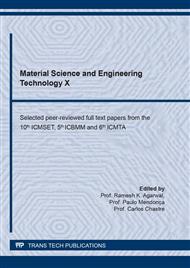[1]
E. Coyle D. and R. Simmons A., Understanding the Global Energy Crisis. (2014).
Google Scholar
[2]
B. H. Kreps, The Rising Costs of Fossil-Fuel Extraction: An Energy Crisis That Will Not Go Away,, Am. J. Econ. Sociol., vol. 79, no. 3, 2020,.
DOI: 10.1111/ajes.12336
Google Scholar
[3]
M. F. Lali and A. Ranji, Review in Microwave Heating Application in Pyrolysis,, Oman Chapter Arab. J. Bus. Manag. Rev., vol. 3, no. 11, 2014,.
DOI: 10.12816/0016523
Google Scholar
[4]
S. Kucukkomur and L. Ozgen, Coffee and Turkish Coffee Culture,, Pakistan J. Nutr., vol. 8, no. 10, p.1693–1700, Sep. 2009,.
DOI: 10.3923/pjn.2009.1693.1700
Google Scholar
[5]
T. E. Rufford, D. Hulicova-Jurcakova, Z. Zhu, and G. Q. Lu, Nanoporous carbon electrode from waste coffee beans for high performance supercapacitors,, in Electrochemistry Communications, (2008).
DOI: 10.1016/j.elecom.2008.08.022
Google Scholar
[6]
J. L. Gómez-Urbano, G. Moreno-Fernández, M. Arnaiz, J. Ajuria, T. Rojo, and D. Carriazo, Graphene-coffee waste derived carbon composites as electrodes for optimized lithium ion capacitors,, Carbon N. Y., vol. 162, 2020,.
DOI: 10.1016/j.carbon.2020.02.052
Google Scholar
[7]
P. Konnerth, D. Jung, J. W. Straten, K. Raffelt, and A. Kruse, Metal oxide-doped activated carbons from bakery waste and coffee grounds for application in supercapacitors,, Mater. Sci. Energy Technol., vol. 4, 2021,.
DOI: 10.1016/j.mset.2020.12.008
Google Scholar
[8]
P. H. Huang, J. W. Jhan, Y. M. Cheng, and H. H. Cheng, Effects of carbonization parameters of Moso-bamboo-based porous charcoal on capturing carbon dioxide,, Sci. World J., 2014,.
DOI: 10.1155/2014/937867
Google Scholar
[9]
Y. Leow, P. Y. M. Yew, P. L. Chee, X. J. Loh, and D. Kai, Recycling of spent coffee grounds for useful extracts and green composites,, RSC Adv., vol. 11, no. 5, 2021,.
DOI: 10.1039/d0ra09379c
Google Scholar
[10]
J. S. Tumuluru, Effect of deep drying and torrefaction temperature on proximate, ultimate composition, and heating value of 2-mm lodgepole pine (Pinus contorta) grind,, Bioengineering, vol. 3, no. 2, 2016,.
DOI: 10.3390/bioengineering3020016
Google Scholar
[11]
C. Djilani, R. Zaghdoudi, A. Modarressi, M. Rogalski, F. Djazi, and A. Lallam, Elimination of organic micropollutants by adsorption on activated carbon prepared from agricultural waste,, Chem. Eng. J., 2012,.
DOI: 10.1016/j.cej.2012.02.059
Google Scholar
[12]
N. E. S. Sazali et al., Preparation and structural characterization of turbostratic-carbon/graphene derived from amylose film,, 2016,.
Google Scholar
[13]
J. Coates, Interpretation of Infrared Spectra, A Practical Approach,, in Encyclopedia of Analytical Chemistry, (2006).
Google Scholar
[14]
D. J. Lyman, R. Benck, S. Dell, S. Merle, and J. Murray-Wijelath, FTIR-ATR analysis of brewed coffee: Effect of roasting conditions,, J. Agric. Food Chem., 2003,.
DOI: 10.1021/jf0209793
Google Scholar
[15]
L. F. Ballesteros, J. A. Teixeira, and S. I. Mussatto, Chemical, Functional, and Structural Properties of Spent Coffee Grounds and Coffee Silverskin,, Food Bioprocess Technol., 2014,.
DOI: 10.1007/s11947-014-1349-z
Google Scholar
[16]
C. O. Ania, Surface chemistry of green carbons,, in Green Carbon Materials - Advances and Applications, (2014).
Google Scholar


